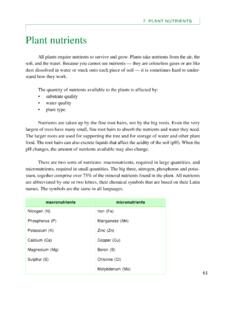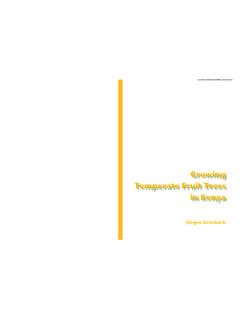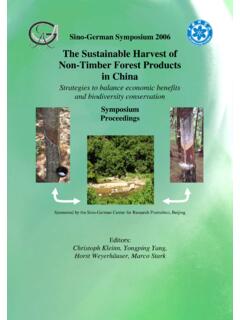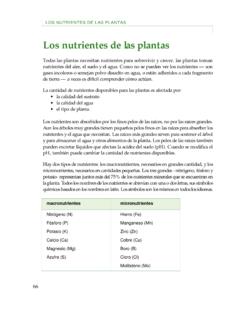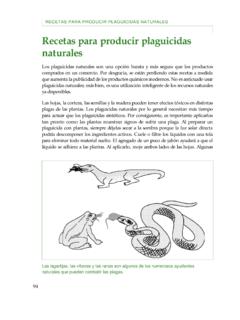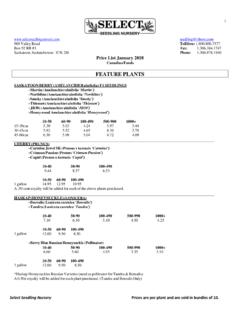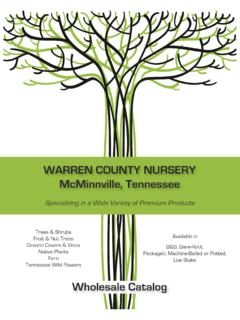Transcription of Nursery management, tree propagation and …
1 Moses R Munjuga, Agnes N Gachuiri, Daniel A Ofori, Mathew M Mpanda, Jonathan K Muriuki, Ramni H Jamnadass and Jeremias MowoNursery management , tree propagation and marketingA training manual for smallholder farmers and Nursery operatorsCorrect citation: Munjuga MR, Gachuiri AN, Ofori DA, Mpanda MM, Muriuki JK, Jamnadass RH, Mowo JG. management , tree propagation and marketing : A training manual for smallholder farmers and Nursery operators. Nairobi: World Agroforestry CentrePublished by the World Agroforestry Centre United Nations AvenuePO Box 30677, GPO 00100 Nairobi, KenyaTel: +254(0)20 7224000, via USA +1 650 833 6645 Fax: +254(0)20 7224001, via USA +1 650 833 6646 Email: Website: World Agroforestry Centre 2013 ISBN: 978-92-9059-339-3 The information appearing in this publication may be quoted or reproduced without charge, provided the source is acknowledged.
2 No use of this publication may be made for resale or other commercial information contained in this publication is based on knowledge and understanding at the time of writing. However, because of advances in knowledge, users are reminded of the need to ensure that information, which they rely on, is up-to-date and to check currency of the information with the appropriate agricultural or forest officer or an independent advisorFront cover photo: (From left, clockwise) Practical training session at ICRAF, HQ Nursery ; Satellite Nursery training session at Mwala DEB Primary School, Machakos county and Theory training session at Machakos ATCBack cover photo: (From left, clockwise) Theory training session at Mbarali, Tanzania.
3 Pumping water with money-maker pump for community Nursery water supply; Group satellite Nursery and Farmer displaying packed seeds ready for saleTABLE OF CONTENTSACKNOWLEDGEMENTS ..viiABOUT THIS MANUAL ..viiiACRONYMS AND ABBREVIATIONS ..ixINTRODUCTION ..1 Definitions ..2 MODULE 1: SEED SOURCES AND Nursery management PRACTICES ..3 Seed sourcing, collection and selection for rootstocks production ..4 management practices of germination beds ..8 Practices in seed handling for germination ..10 Selecting pricking out and transplanting of germinated seeds to polythene pots ..11 MODULE 2: ESTABLISHMENT AND management OF A SEEDLING Nursery .
4 13 Nursery site selection ..14 Nursery design and construction ..15 Materials for tree nurseries ..16 Activities ..16 Planning and record keeping ..19 MODULE 3: PRODUCTION OF VEGETATIVE PLANTING MATERIALS ..21 Vegetative propagation ..22 Concepts and principles of grafting ..23 Activity ..24 Concepts and principles of budding ..24 Concepts and principles of cuttings ..26 MODULE 4: MAKING COMPOST IN THE Nursery ..31 What is composting? ..32 Compost compost maturity ..33 Home composting methods ..34 MODULE 5: THE Nursery AS A the Nursery business ..36 Critical risks or situation analysis ..36 Developing a business plan for the Nursery .
5 38 Types of Nursery businesses ..38 Licensing, permits and regulations ..39 Defining competition ..39 Defining the market ..39 marketing strategy ..39 Sales strategy ..40 What product mix?..40 marketing mix ..42 Nursery business prospectus ..43 FEEDBACK ..44 ANNEX: SAMPLE PROGRAMME OF A WORKSHOP ON Nursery management AND tree propagation TECHNIQUES ..47 FURTHER READING ..49A training manual for smallholder farmers and Nursery operatorsviiQuestions that should guide the trainer feedback reporting 46 ACKNOWLEDGEMENTSThis training manual was made possible through the support of various individuals and institutions: Machakos ATC, District Executive Director Mbarali, Ministry of Agriculture (Kenya and Tanzania), Tanzania Forest Service, Kenya Forest Service, local authorities (Kenya and Tanzania), Nursery operators, farmers and national agricultural institutions.
6 We would like to express our sincere thanks and appreciation for your are also grateful to our colleagues in the Evergreen Agriculture Project for their support and valuable inputs that made this work a training manual for smallholder farmers and Nursery operatorsviiiABOUT THIS MANUALThis publication covers the principles and practices in the production of quality and superior planting materials from seeds to seedlings grown in the nurseries. The aim of this manual is to familiarize the Nursery operators, farmers and institutional nurseries with, and to get them involved in, the project techniques of propagation and establishment of small scale-nurseries.
7 The learning activities in this manual are presented in five different covered in module 1 include sourcing and selection of seeds for seedlings or rootstock propagation , preparation of seedbed and germination medium, techniques of enhancing seed germination and sowing of seeds in the germination bed, uprooting and transplanting of germinated seeds in the 2 deals with topics on the establishment and management of nurseries. The activities include site selection and land preparation, field layout and planting techniques, seedling management , weeding and control of seedling concepts, principles of practising vegetative propagation and the steps with illustrations on the production of quality planting materials through various methods of asexual propagation are presented in module 4 deals with making of compost and mixing of the soil in the Nursery .
8 The learning activities include mixing of media and making of compost from the Nursery 5 discusses the tree Nursery as an enterprise or publication: Provides flexibility in planning, conducting and evaluating training courses. Allows trainers to formulate their own training schedule based on results from the training needs assessments. Can easily be adapted to suit different cultures by reviewing case studies and applying only those that are appropriate to their situations. Additional case studies can be devised based on local statistics, cultural practices and social issues. Learning outcomesBy the end of the training, participants should be able to.
9 Define a tree Nursery Demonstrate various technologies on tree Nursery development and management practices Outline the basic principles and criteria for evaluating seedling quality Mix suitable soil media for potting up seedlings and cuttings Germinate seeds, transplant seedlings and cuttings into pots correctly Understand the significance and importance of tending and checking seedlings in the Nursery Develop entrepreneurial skills in tree seedling productionA training manual for smallholder farmers and Nursery operatorsixACRONYMS AND ABBREVIATIONSDED District Executive DirectorICRAF World Agroforestry CentreKFS Kenya Forestry ServiceMoA Ministry of AgricultureRRC Rural Resource CentreTFS Tanzania Forestry ServiceTOT Training of TrainersA training manual for smallholder farmers and Nursery operators11 Seedling production is one of the key steps
10 In scaling up or domestication of any species. Each step has to be properly planned and implemented. The way seedlings are handled and managed in a Nursery contributes to their survival rate after planting and their subsequent growth performance. Improving seedling quality correlates positively to their survival, growth and productivity. Seedling quality is governed by the genetic make-up of the parent trees and the physical growth of the seedlings. Several types of nurseries exist: individual or private, community or group, central or research, commercial and training practices must be consistent and the various techniques closely integrated.

